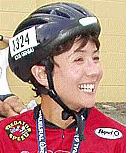 |  | |||||||||||||||||||||||||||||||||||||||
 | ||||||||||||||||||||||||||||||||||||||||
Planet column: Skate Coach
Or How to Avoid Falls As You Begin Inline Skating
By Kathy McSparran, certified inline instructor Staying up? No, this is not another Viagra ad. Nor is it a discussion of staying awake, positive or peppy. No, today we're talking about staying up as in staying vertical, avoiding the emergency room and living to play another day. In short, we want you to learn to skate with as few bumps and bruises as possible. If you're a new skater, you've probably already heard the standard advice that you should wear proper safety gear, stay off hills and take a lesson with a certified instructor. Yeah, yeah .... yadda-yadda-yadda. Look Ma, No Hands The reality is that most people don't follow this advice, even though it's extremely valid. Why? ... Well, let's start with the safety gear. First of all, the experienced skaters we see gliding effortlessly down the trail make skating look deceptively easy, and many times they don't wear all the gear. So we're lulled into thinking we don't need it either. But forget that graceful image of the gliding pro. As a new skater, your first experience will feel more like strapping bars of soap to your feet and stepping into a wet bathtub! Are you feeling that urge to wrap yourself in bubble wrap yet? Good! ... Wear the gear: helmet, wrist guards, knee and elbow pads. Additionally, some skaters don a pair of their son's old padded ice hockey shorts for tailbone protection. Admittedly, those of you with experience in one of the other "sliding sports" may bypass much of the bar-of-soap effect ... until you try to stop. Human Hood Ornament You see, skis, ice skates and roller skates don't have heel brakes. So you folks are actually in a higher risk category than the complete newbies. You'll be able to get up to speed (literally) in no time, and it will be precisely then that you will remember that you don't know how to use a heel brake. You will then get to invent exciting and creative new ways to stop, like the crash-in-the-grass stop, the human hood ornament, and the daring "whiz around the lamppost" stop. While I'm all for creativity, in this case I recommend saving yourself some bodily harm by scoping out a completely level, obstacle free spot to practice until you are stopping with a screech and/or leaving a heel brake skid mark on the pavement when you stop. These are indications that you are getting enough friction on the brake to begin to control your speed on some declines. Even then, start with very small, gradual slopes with long outruns and follow the "brake early and often" rule of thumb. (Continued ...) Part 1|2 >>>
| Discuss Related reading • Read more of Kathy McSparran's Skate Coach columns | |||||||||||||||||||||||||||||||||||||||
Copyright © 2005 by Robert Burnson | ||||||||||||||||||||||||||||||||||||||||
